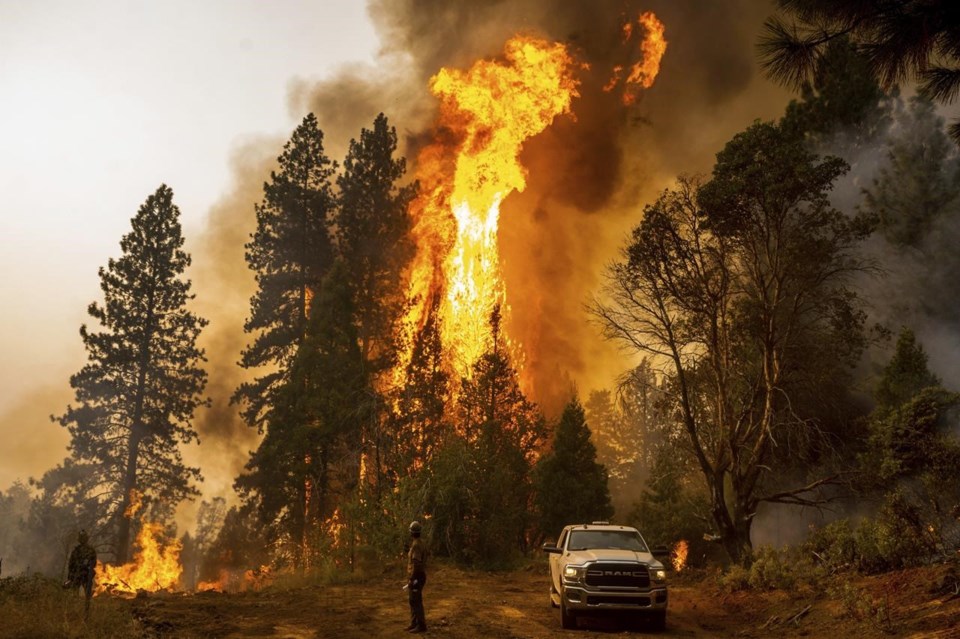BILLINGS, Mont. (AP) ŌĆö The U.S. is directing $930 million toward in 10 western states by clearing trees and underbrush from national forests, the Biden administration announced Thursday, as officials struggle to protect communities from destructive infernos being made worse by climate change.
Under a strategy now entering its second year, the U.S. Forest Service is trying to prevent out-of-control fires that start on public lands from raging through communities. But in an interview with The Associated Press, U.S. Agriculture Secretary Tom Vilsack acknowledged that the shortage of workers that has been plaguing other sectors of the economy is hindering the agency's wildfire efforts.
He warned that ŌĆ£draconianŌĆØ budget cuts floated by some Republicans, who control the U.S. House, could also undermine the Democratic administration's plans. Its goal is to lower wildfire risks across almost 80,000 square miles (200,000 square kilometers) of public and private lands over the next decade.
The work is projected to cost up to $50 billion. Last yearŌĆÖs climate and infrastructure bills combined directed about $5 billion to the effort.
ŌĆ£There's one big ŌĆśif,' " Vilsack said. ŌĆ£We need to have a good partner in Congress.ŌĆØ
He added that fires on public lands will continue to threaten the West, after burning about 115,000 square miles (297,000 square kilometers) over the past decade ŌĆö an area larger than Arizona ŌĆö and destroying about 80,000 houses, businesses and other structures, according to government statistics and the nonpartisan research group Headwaters Economics.
Almost 19,000 of those structures were torched in the 2018 Camp Fire that in Paradise, Calif.
ŌĆ£It's not a matter of whether or not these forests will burn," Vilsack said. "The crisis is upon us.ŌĆØ
The sites targeted for spending in 2023 cover much of Southern California, home to 25 million people; the Klamath River Basin on the Oregon-California border; San Carlos Apache Reservation lands in Arizona; and the Wasatch area of northern Utah, a tourist draw with seven ski resorts. Other sites are in Idaho, Oregon, Nevada, Washington state, Colorado, New Mexico and Montana.
The idea is to remove many trees and other flammable material from hotspots that make up only a small portion of fire-prone areas but account for about 80% of risk to communities. Vilsack said officials will seek to restore ŌĆ£ ŌĆØ ŌĆö meaning fewer but larger trees that can be resilient against fires.
House Natural Resources Committee Chairman Bruce Westerman said he was glad to see the Biden administration taking ŌĆ£long-overdue actionŌĆØ and streamlining forest management rules. But Westerman questioned why more money will be spent this year even as new projects include fewer acres compared with last year, according to administration documents.
ŌĆ£The Forest Service is still recklessly spending valuable taxpayer dollars with little to no accountability,ŌĆØ the Arkansas Republican said in a statement.
A Vilsack aide said there were ŌĆ£no apples-to-apples comparisons" between costs among the landscapes, which differ in terrain, access and the state of the forest. Staffing and equipment issues also factor in, and the differences can make some areas more expensive and time-intensive, spokesperson Marissa Perry said.
ŌĆ£We work to treat not only the most acreage we can, but where it makes the most difference with the resources available,ŌĆØ she said.
Some said the administration remained overly focused on stopping fires ŌĆö a near-impossible goal ŌĆö with not enough money and resources going to communities and people at risk, including the elderly and people with medical conditions or disabilities.
ŌĆ£Given the scale of how much needs to be done, we are just skimming the surface,ŌĆØ said Headwaters Economics researcher Kimiko Barrett. ŌĆ£Risks are increasing at a scale and magnitude that we haven't seen historically. You're seeing entire neighborhoods devastated.ŌĆØ
Vilsack said the projects announced so far will help reduce wildfire risk to around 200 communities in the western U.S.
Warming temperatures have dried out the region's landscape and driven insect outbreaks that have killed millions of trees ŌĆö ideal conditions for massive wildfires.
The impacts stretch across North America, with smoke plumes at the height of wildfire season in the U.S. and Canada sometimes causing thousands of miles away on the East Coast.
Last yearŌĆÖs work by the Forest Service included tree thinning and controlled burns across 5,000 square miles (13,000 square kilometers) of forest nationwide, Vilsack said.
ŌĆ£We're very targeted in saying, ŌĆśHereŌĆÖs where we need to go to reduce the risk,'ŌĆØ Forest Service Deputy Chief Chris French told the AP.
But a key piece of the administration's strategy ŌĆö intentionally setting small fires to reduce the amount of vegetation available to burn in a major blaze ŌĆö already has encountered problems: The program was suspended three months last spring after a devastating wildfire near Las Vegas, New Mexico, burned across more than 500 square miles (1,295 kilometers) in the southern reaches of the Rocky Mountains.
It was the state's largest fire on record, and several hundred homes were destroyed. Experts have said the environmental damage will linger generations.
Congress has approved nearly $4 billion in assistance for the fire's victims, including $1.5 billion in the massive spending bill passed last month.
ŌĆ£If you're a community, you're going to have to worry about not just nature's fires, but the government's fires, too," said Andy Stahl, executive director of the advocacy group Forest Service Employees for Environmental Ethics. ŌĆ£New Mexico taught us that.ŌĆØ
Matthew Brown, The Associated Press



